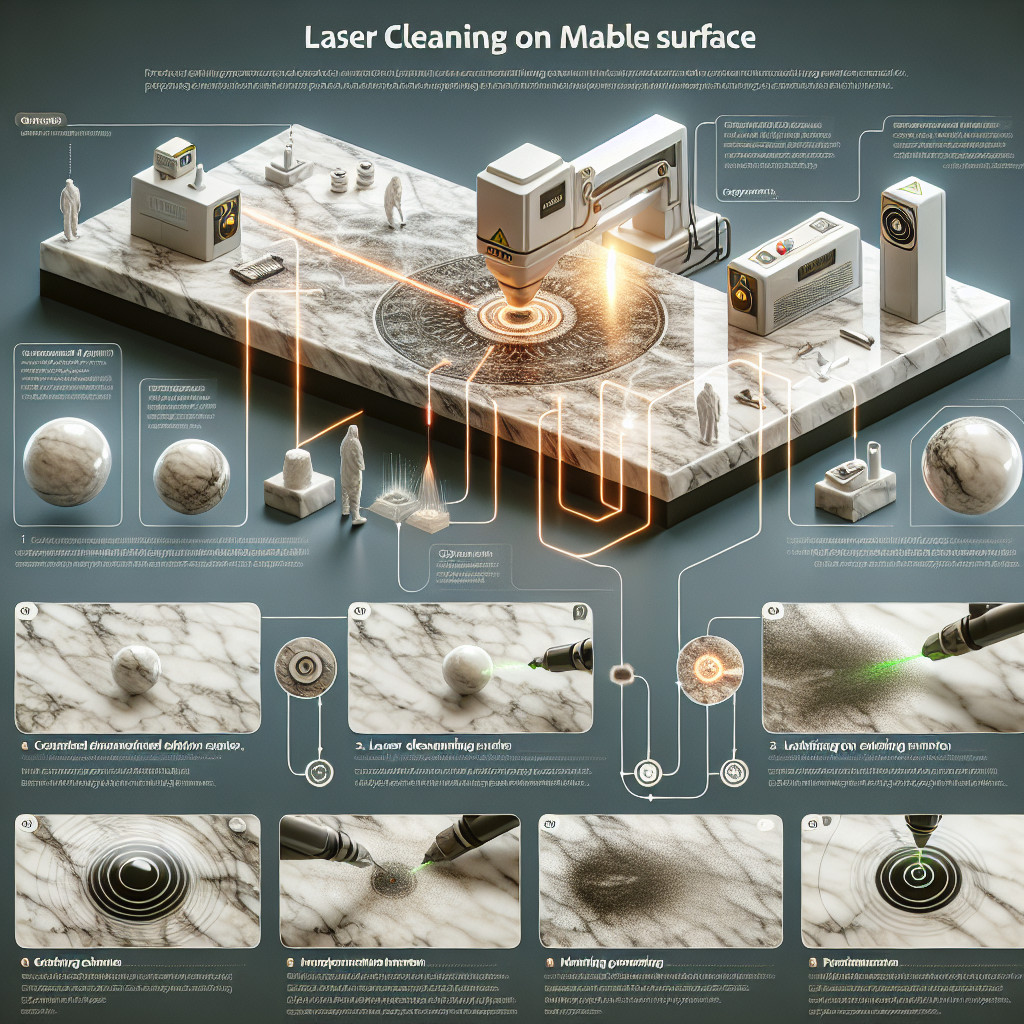
Laser cleaning for removing contaminants from marble surfaces
- Benefits of Laser Cleaning for Marble Surfaces
- Techniques Used in Laser Cleaning for Marble Surfaces
- Comparison of Laser Cleaning vs. Traditional Cleaning Methods for Marble Surfaces
- Safety Considerations for Laser Cleaning on Marble Surfaces
- Case Studies of Successful Laser Cleaning on Marble Surfaces
Benefits of Laser Cleaning for Marble Surfaces
1. Non-abrasive Cleaning
One of the main advantages of laser cleaning is that it is a non-abrasive method. Unlike traditional cleaning methods that involve scrubbing and harsh chemicals, laser cleaning uses a focused beam of light to remove dirt and stains from the surface of the marble. This means that there is no risk of scratching or damaging the marble during the cleaning process.
2. Precision Cleaning
Laser cleaning is a highly precise method that allows for targeted cleaning of specific areas on the marble surface. The laser beam can be adjusted to different intensities and sizes, allowing for precise control over the cleaning process. This makes it ideal for removing stubborn stains or dirt from hard-to-reach areas on the marble surface.
3. Environmentally Friendly
Unlike traditional cleaning methods that often involve the use of harsh chemicals, laser cleaning is an environmentally friendly option. The process does not produce any harmful fumes or residues, making it a safe and sustainable cleaning solution for marble surfaces. This is especially important for indoor spaces where air quality is a concern.
4. Time and Cost Savings
Laser cleaning is a fast and efficient method that can save time and money compared to traditional cleaning methods. The process is quick and does not require the use of multiple cleaning products or tools. This can result in significant cost savings for businesses or homeowners looking to clean their marble surfaces.
5. Preservation of Marble’s Natural Beauty
One of the key is that it helps to preserve the natural beauty of the stone. The gentle cleaning process removes dirt and stains without damaging the surface of the marble, allowing its natural color and veining to shine through. This can help to prolong the life of the marble and maintain its aesthetic appeal for years to come.
In conclusion, laser cleaning offers a range of benefits for cleaning marble surfaces. From its non-abrasive and precise cleaning capabilities to its environmentally friendly and cost-effective nature, laser cleaning is a modern and efficient solution for restoring the beauty of marble surfaces. Whether you are a homeowner looking to clean your marble countertops or a business owner with marble floors, laser cleaning is a versatile and effective cleaning option to consider.
Techniques Used in Laser Cleaning for Marble Surfaces
Techniques
| Technique | Description | Advantages | Limitations |
|---|---|---|---|
| Surface Cleaning | This technique involves removing surface contaminants such as dirt, dust, and grime from the marble surface. | Effective for light cleaning tasks, does not damage the marble surface. | May not be effective for deep-seated stains or heavy grime. |
| Stain Removal | Used to target specific stains on the marble surface, such as wine or oil stains. | Highly targeted and precise, can remove stubborn stains. | May require multiple passes for deep stains, can damage the marble if not used properly. |
| Grout Cleaning | Targets grout lines between marble tiles to remove dirt and grime buildup. | Effective for cleaning hard-to-reach areas, improves overall appearance of the marble surface. | Requires precise control to avoid damaging the marble tiles. |
Benefits of Laser Cleaning
Laser cleaning offers several benefits for cleaning marble surfaces. Some of the key advantages include:
- Non-contact cleaning method that does not damage the marble surface
- Precise control over cleaning parameters for targeted cleaning tasks
- Environmentally friendly, as it does not require the use of harsh chemicals
- Efficient and effective for removing a wide range of contaminants
Overall, laser cleaning is a versatile and effective method for maintaining the beauty and integrity of marble surfaces. By using the right techniques and equipment, it is possible to achieve excellent results without causing damage to the marble.
Comparison of Laser Cleaning vs. Traditional Cleaning Methods for Marble Surfaces
Traditional Cleaning Methods
Traditional cleaning methods for marble surfaces typically involve the use of chemical cleaners, scrubbing brushes, and water. These methods can be effective in removing dirt and grime from the surface of the marble, but they can also be abrasive and potentially damaging to the marble itself. Additionally, traditional cleaning methods can be time-consuming and labor-intensive.
Some common traditional cleaning methods for marble surfaces include:
- Using a mild detergent and water to clean the surface
- Scrubbing the surface with a soft-bristled brush
- Using a poultice to remove stains
While traditional cleaning methods can be effective in cleaning marble surfaces, they may not always be the best option for delicate or valuable marble surfaces.
Laser Cleaning
Laser cleaning is a relatively new method for cleaning marble surfaces that involves the use of a laser to remove dirt, grime, and stains from the surface of the marble. This method is non-abrasive and non-contact, meaning that it does not damage the marble surface in any way. Laser cleaning is also highly effective in removing even the toughest stains from marble surfaces.
Some benefits of laser cleaning for marble surfaces include:
- Non-abrasive and non-contact, so it does not damage the marble surface
- Highly effective in removing tough stains
- Fast and efficient
- Environmentally friendly, as it does not require the use of harsh chemicals
While laser cleaning can be a more expensive option compared to traditional cleaning methods, it is often worth the investment for delicate or valuable marble surfaces.
Conclusion
When it comes to cleaning marble surfaces, both traditional cleaning methods and laser cleaning have their pros and cons. Traditional cleaning methods can be effective in removing dirt and grime from the surface of the marble, but they can also be abrasive and potentially damaging. Laser cleaning, on the other hand, is non-abrasive and highly effective in removing tough stains, but it can be more expensive.
Ultimately, the best cleaning method for marble surfaces will depend on the specific needs of the surface and the budget of the individual. For delicate or valuable marble surfaces, laser cleaning may be the best option, while traditional cleaning methods may be more suitable for less delicate surfaces.
Regardless of the method chosen, it is important to regularly clean and maintain marble surfaces to ensure their longevity and beauty.
Safety Considerations for Laser Cleaning on Marble Surfaces
Types of Lasers
There are several types of lasers that can be used for cleaning marble surfaces, including:
| Laser Type | Wavelength | Power Output |
|---|---|---|
| CO2 Laser | 10.6 microns | Up to 100 watts |
| Nd:YAG Laser | 1064 nanometers | Up to 100 watts |
| Fiber Laser | Various wavelengths | Up to 500 watts |
Safety Precautions
When using lasers for cleaning marble surfaces, it is important to follow these safety precautions:
- Wear appropriate protective gear, such as safety glasses and gloves, to protect against laser radiation and debris.
- Ensure proper ventilation in the work area to prevent the buildup of fumes and dust from the cleaning process.
- Use a laser with the appropriate wavelength and power output for the specific type of marble being cleaned.
- Avoid pointing the laser directly at the surface for an extended period of time to prevent overheating and damage.
- Regularly inspect the laser equipment for any signs of wear or damage and perform maintenance as needed.
Benefits of Laser Cleaning
Despite the safety considerations, laser cleaning offers several benefits for cleaning marble surfaces, including:
- Non-contact cleaning method that does not require harsh chemicals or abrasive materials.
- Precision cleaning that can target specific areas without affecting the surrounding surface.
- Efficient removal of dirt, grime, and other contaminants without leaving behind residue.
- Environmentally friendly process that does not produce harmful waste or emissions.
Conclusion
Overall, laser cleaning can be a safe and effective method for cleaning marble surfaces when proper safety precautions are followed. By using the right type of laser, wearing protective gear, and following best practices, operators can achieve clean and pristine marble surfaces without causing damage or harm.
Case Studies of Successful Laser Cleaning on Marble Surfaces
Marble surfaces are known for their beauty and elegance, but over time they can become dirty and stained. Traditional cleaning methods such as scrubbing and chemical cleaners can be harsh on the delicate surface of marble, leading to damage and discoloration. Laser cleaning has emerged as a safe and effective alternative for restoring marble surfaces to their original beauty. In this article, we will explore some .
Case Study 1: Historic Marble Statue
A historic marble statue located in a museum was in need of cleaning due to years of dirt and grime buildup. Traditional cleaning methods were deemed too risky due to the delicate nature of the statue. Laser cleaning was chosen as a non-invasive and gentle method for removing the dirt without causing any damage to the marble surface. The laser was able to penetrate the dirt and grime, lifting it off the surface without leaving any residue behind. The end result was a beautifully restored statue that looked as good as new.
Key Takeaway: Laser cleaning is a safe and effective method for cleaning delicate marble surfaces without causing damage.
Case Study 2: Marble Flooring in a Luxury Hotel
A luxury hotel with marble flooring in the lobby area was looking to refresh the look of the marble without causing any disruption to guests. Traditional cleaning methods would have required the area to be closed off for an extended period of time, leading to lost revenue for the hotel. Laser cleaning was chosen as a quick and efficient method for cleaning the marble flooring without the need for any downtime. The laser was able to remove years of dirt and grime from the marble, leaving behind a clean and polished surface that impressed both guests and staff.
Key Takeaway: Laser cleaning is a fast and efficient method for cleaning large marble surfaces without causing any disruption.
Case Study 3: Marble Countertops in a High-End Kitchen
A high-end kitchen with marble countertops was in need of cleaning due to stains and discoloration. Traditional cleaning methods had proven ineffective at removing the stubborn stains. Laser cleaning was chosen as a last resort for restoring the marble countertops to their original beauty. The laser was able to target the stains directly, breaking them down and lifting them off the surface without causing any damage to the marble. The end result was a set of marble countertops that looked brand new and added a touch of luxury to the kitchen.
Key Takeaway: Laser cleaning is a powerful method for removing stubborn stains from marble surfaces without causing damage.
In conclusion, these case studies demonstrate the effectiveness of laser cleaning on marble surfaces. Whether it’s a historic statue, luxury hotel flooring, or high-end kitchen countertops, laser cleaning has proven to be a safe and efficient method for restoring the beauty of marble without causing any damage. If you have marble surfaces in need of cleaning, consider using laser cleaning for a safe and effective solution.
- Laser cleaning for removing contaminants from marble surfaces - 7 August 2024
